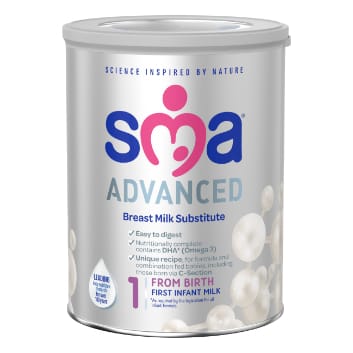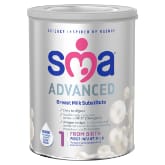Rapid postnatal weight gain can result from a high intake of growth-enhancing nutrients, such as protein, in the infant diet. Evidence from the Childhood Obesity Project study20, a large independent randomised controlled trial, suggests that higher protein intakes increase plasma and tissue levels of insulin-releasing amino acids, and of insulin and insulin-like growth factor, thereby increasing weight gain and adipogenic activity.20-22
SCIENCE INSPIRED BY NATURE†
SMA® ADVANCED First Infant Milk
A nutritionally complete* infant milk suitable from birth, it can be used for infants who are not being breastfed or who are being combination fed.
Product description


Contains 2’FL, DFL, LNT, 3’SL, 6’SL.

Contains Zinc and vitamins A, C & D to help support the normal function of babies immune system1-3

Contains 1.27g of protein per 100ml that is broken down into smaller pieces (partially hydrolysed 100% whey protein)4

Contains DHA (Omega 3) as required by the legislation for all infant formula

Suitable for C-section babies **5
Breastfeeding is the best source of nutrition for infants. In a study which investigated the effects of human milk oligosaccharides on infants gut health,infants fed formula supplemented with 2’FL, DFL, LNT, 3’SL, 6’SL had:
- Higher abundance of beneficial bifidobacteria, including B infantis (one of the predominant species in breastfed infants)†5
- Lower abundance of pathogens: significant reduction in toxigenic Clostridioides difficile, reducing a risk factor for GI infection (C difficile diarrhoea)†5
- Higher levels of secretory immunoglobulin A (sIgA)†5
- Higher abundance of beneficial Bifidobacterium in infants born via c-section at 6 months†5
Research suggests that breastfed babies have fewer infections and may have a stronger immune system,6 which in part may be due to the presence of human milk oligosaccharides (HMOs).7-8Click here for more information about HMOs
The growth pattern of a breastfed baby is associated with improved health outcomes.9-11 Breastfed babies tend to grow more slowly than bottle-fed babies.9-11 Protein is one of the main drivers of growth, and the quantity and quality of protein in breast milk are ideal to support appropriate growth.
For information on suitability for use in Halal diets please contact the Careline on 0800 081 81 80 (UK) or 1800 931 832 (Ireland).
*As required by the legislation for all infant formula
**At 6 months vs control
†Secondary outcome
DHA, Docosahexaenoic acid
Data card
Formats

800 g Powder
The scoop is provided under the lid. It can be stored in suspension inside the can.
Comparison charts
| SMA® ADVANCED First Infant Milk | Aptamil ADVANCED First Infant Milk12-13 | |
|---|---|---|
| Contains latest breakthrough in infant nutrition - a unique 5-HMO Complex (2’FL, DFL, LNT, 6’SL and 3’SL) | ||
| Easy-to-digest, 100% whey dominant, partially hydrolysed protein | ||
| Contains DHA (Omega 3) | ||
| Nutritionally complete |
Preparation
How to open and prepare your baby's feed – powder (800 g)
While this product is made under strict hygienic conditions, it is not sterile. Failure to follow instructions on preparation and storage may make your baby ill.

Pull the safety seal and open the lid. Lift the tab, pull on the foil seal, carefully and safely remove the seal and dispose of it.

Wash hands well. Wash and sterilise all utensils according to manufacturers’ instructions.

Boil 1 litre of fresh tap water. Allow boiled water to cool for no more than 30 minutes. Do not use artificially softened or repeatedly boiled water.

Strictly follow the feeding table. First, pour water into a sterilised bottle, carefully - it is hot. Then add the powder using only the scoop provided, carefully levelling off each scoop with the back of a clean dry knife. Store the scoop across the inner rim of the can and replace the lid.

Place the sterilised teat and cap on the bottle and shake well until powder is fully dissolved. Cool bottle under cold running water or in a bowl or jug of cold water until lukewarm, do not immerse the teat. Test temperature by shaking a few drops onto the inside of your wrist.
Feeding guide
|
Feeding guide birth – 12 months |
||||||
|
Approx. age of baby |
Approx. weight of baby |
Preparation for single feeds |
Feeds in 24 hours |
|||
|
Cooled, freshly boiled water |
||||||
|
kg |
lb |
Level scoops |
ml |
fl. oz. (approx.) |
||
|
Birth – 2 weeks |
3.4 |
7½ |
3 |
90 |
3 |
6 |
|
2 – 4 weeks |
3.7 |
8 |
4 |
120 |
4 |
6 |
|
4 – 8 weeks |
4.2 |
9¼ |
4 |
120 |
4 |
6 |
|
2 months |
5.3 |
11¾ |
5 |
150 |
5 |
5 |
|
3 months |
6.1 |
13½ |
6 |
180 |
6 |
5 |
|
4 months |
6.7 |
14¾ |
6 |
180 |
6 |
5 |
|
6 months |
7.6 |
16¾ |
8 |
240 |
8 |
4 |
|
7 – 12 months |
- |
- |
7 |
210 |
7 |
3 |
This table is a guide only; a baby may need more or less than the volumes stated. If you require more advice, consult your healthcare professional. Remember to feed your baby on demand.
Mix 1 scoop of powder to 30 ml (approx. 1 fl. oz.) of water. Approx. 181 scoops per can (applicable to 800 g can only). 1 scoop = 4.4 g.
Important feeding information
SMA® ADVANCED First Infant Milk - 800g
|
|
Do not add extra powder or water to make the feeds stronger or weaker and do not press powder into scoop. Using too much or too little powder can make your baby ill. |
|
|
We recommend preparing each feed in individual bottles when required. |
|
|
For hygienic reasons, discard unfinished feed in the bottle as soon as possible. |
|
|
For older babies, made-up formulae can be added to food. |
|
|
Do not alter or add to formulae unless medically directed. |
|
|
Do not warm feeds in a microwave, hot spots may occur and cause scalding. |
|
|
Remember, cows' milk should not be used as a drink during the first year. |
-
EFSA Panel on Dietetic Products, Nutrition and Allergies (NDA). (2014). Scientific Opinion on the substantiation of a health claim related to zinc and normal function of the immune system pursuant to Article 14 of Regulation (EC) No 1924/2006. EFSA Journal, 12(5), 3653.
-
Mora J, et al. Vitamin Effects on the Immune System: Vitamins A and D Take Centre Stage Nat Rev Immunol 2008; 8(9): 685–98.
-
EFSA Panel on Dietetic Products, Nutrition and Allergies (NDA). (2015). Vitamin C and contribution to the normal function of the immune system: evaluation of a health claim pursuant to Article 14 of Regulation (EC) No 1924/2006. EFSA Journal, 13(11), 4298.
-
Based Infant Formulas. Int J Pediatr 2018; 2018: 4969576.
-
Bosheva, M., Tokodi, I., Krasnow, A., Pedersen, H. K., Lukjancenko, O., Eklund, A. C., Grathwohl, D., Sprenger, N., Berger, B., Cercamondi, C. I., & 5 HMO Study Investigator Consortium (2022). Infant Formula With a Specific Blend of Five Human Milk Oligosaccharides Drives the Gut Microbiota Development and Improves Gut Maturation Markers: A Randomized Controlled Trial. Frontiers in nutrition, 9, 920362. https://doi.org/10.3389/fnut.2022.920362
-
Victora CG, et al. Lancet 2016; 387: 475–90.
-
Kunz C. Adv Nutr 2012; 3(3): 430S–9S
-
Bode L. Glycobiology 2012; 22(9): 1147–62.
-
WHO Multicentre Growth Reference Study Group. Acta Paediatr Suppl 2006; 450: 76–85.
-
Baird J, et al. BMJ 2005; 331: 929.
-
Kramer MS, et al. J Pediatr 2004; 145: 600–5.
-
SMA® ADVANCED First Infant Milk datacard. Available at: https://www.smahcp.ie/formula-milk/advanced-first-infant-milk (accessed March 2023).
-
SMA® PRO First Infant Milk datacard. Available at: https://www.smahcp.ie/formula-milk/pro-first-infant-milk (accessed March 2023)
-
Aptamil Advanced First Infant Milk datacard. Available at: https://www.nutricia.co.uk/hcp/products.html (accessed March 2023)
-
Aptamil First Infant Milk datacard. Available at: https://www.nutricia.co.uk/hcp/products.html (accessed March 2023).
-
HiPP Organic First Infant Milk datacard. Available at: https://www.hipp4hcps.co.uk/fileadmin/media_hcp/pdf/HiPP_organic_infant_milk_powder_datacard_030320.pdf (accessed May 2020).
-
Cow & Gate First Infant Milk datacard. Available at: https://www.nutricia.co.uk/hcp/products.html (accessed March 2023).
-
Piccolo Organic First Infant Milk. Available at https://www.mylittlepiccolo.com/milk/first-infant/ (accessed March 2023)
-
Totzauer M et al., Obesity 2018;26(7):1023-10
-
Koletzko B, et al. Am J Clin Nutr 2009; 89: 1836–45
-
Kirchberg FF, et al. J Clin Endocrinol Metab 2015; 100(1): 149–58
-
Weber M, et al. Am J Clin Nutr 2014; 99
IMPORTANT NOTICE:
We believe that breastfeeding is the ideal nutritional start for babies and we fully support the World Health Organization’s recommendation of exclusive breastfeeding for the first six months of life followed by the introduction of adequate nutritious complementary foods along with continued breastfeeding up to two years of age. We also recognise that breastfeeding is not always an option for parents. We recommend that healthcare professionals inform parents about the advantages of breastfeeding. If parents choose not to breastfeed, healthcare professionals should inform parents that such a decision can be difficult to reverse and that the introduction of partial bottle-feeding will reduce the supply of breast milk. Parents should consider the social and financial implications of the use of infant formula. As babies grow at different rates, healthcare professionals should advise on the appropriate time for a baby to begin eating complementary foods. Infant formula and complementary foods should always be prepared, used and stored as instructed on the label in order to avoid risks to a baby’s health. The product should be used only on the advice of independent persons having qualifications in medicine, nutrition, pharmacy, or other professionals responsible for maternal and child care.

